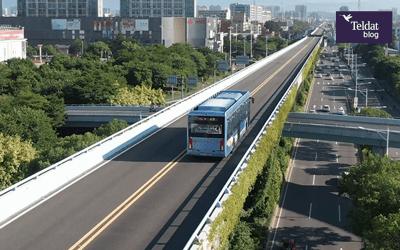 When we hear about automotive electronics as a specific field of electronic engineering, one often wonders what makes it so special. As regular consumers, we are familiar with consumer electronics and tend to believe that everything (design, manufacturing, and testing) can be replicated in the same manner.
When we hear about automotive electronics as a specific field of electronic engineering, one often wonders what makes it so special. As regular consumers, we are familiar with consumer electronics and tend to believe that everything (design, manufacturing, and testing) can be replicated in the same manner.
However, a multimedia electronic device (or one used to process or transmit data) that is going to be used at home or a small office is very different to one installed in a hospital, factory, vehicle, train, airplane, military installation, or space satellite (to the point where using it in another environment is out of the question). The conditions in each of these scenarios are so diverse that the electronics are designed in a radically different manner. Companies and engineers often need to train and specialize in a given application.
A key and sensitive point in electronic devices is the power supply. Consumer devices will use the power grid or a stabilized AC/DC power supply unit, whereas automotive devices will be powered by the vehicle’s battery. Even if both have the same nominal voltage (12 V DC), the vehicle’s power supply must be far more protected against electrical disturbances (such as surges, ripple spikes or power outages). We do not want to drain the battery by leaving a device on, but we don’t want the device to switch off if the engine stops running momentarily. As a result, two electric lines are needed: the battery voltage and the ignition signal (IGN). This way, the device will switch off automatically a few minutes after the trip ends.
Environmental specifications
Mechanical and climatical environmental specifications are even stricter. Road travel generates vibrations that can damage electronic boards, housings and (notably) electrical signal connectors. In addition, inside a vehicle, extreme temperatures can be recorded. While office routers can be installed simply by putting them on a table, vehicle devices must always be secured and are often placed in small gaps. They often become hotter, and they are harder to replace in the event of a malfunction. In brief, many environmental conditions call for automotive devices to be more robust and reliable.
While there is a specific EU standard for rail devices, this is not the case for automotive electronics. Instead, we have different standards issued by international organizations (governmental or industry-based). For example, the aforementioned requirements on immunity to electrical interference and environmental resilience are covered by ISO 16750-2 and ISO 16750-3 or the E-mark certificate (required by the EU).
ITxPT – IT for public transport
There is currently an industry initiative (launched by non-profit association ITxPT) that aims to define the architecture of devices installed in public transport vehicles. The ITxPT (Information Technology for Public Transport) initiative was launched in 2013 by the UITP (International Association for Public Transport), the CEN (European Committee for Standardization) and the CENELEC (European Committee for Electrotechnical Standardization). Today, ITxPT is a global organization with more than 120 members belonging to the public transport sector (including transport operators, authorities, manufacturers, and IT system integrators).
It provides a common framework of standards and specifications to ensure the compatibility and full interoperability of different hardware and software components used in public transport systems. When they adhere to these standards, router manufacturers and system integrators guarantee their products can communicate and exchange data with other ITxPT compatible products (regardless of the brand or provider).
This interoperability is particularly important when it comes to public transport, where different systems and devices belonging to several manufacturers and providers must work together to give passengers a good user experience. ITxPT – Information Technology for Public Transport standards help guarantee that data exchange and integration between different systems is smooth, efficient, and reliable (allowing public transport operators to optimize their procedures and offer passengers a better service).
In addition, when they adhere to ITxPT standards, router manufacturers and system integrators can differentiate themselves in the market by proving their commitment to interoperability and assuring customers that their products have been designed to work with other ITxPT compatible products.
While ITxPT is not required to install devices in public transport vehicles, it is increasingly becoming an industry standard. Complying with some ITxPT provisions may even be necessary in some public transport contracts and tenders. Many European cities (like Helsinki, Paris, and Stockholm) have adopted ITxPT standards in their public transport systems.
In addition, several national and European initiatives (like the ELIPTIC project, funded by the EU) are promoting the adoption of ITxPT – standards in public transport. Globally, ITxPT is also becoming more accepted and has gained the interest and involvement of transport operators and industry stakeholders in other regions (like North America and Asia-Pacific). In 2020, ITxPT signed a Memorandum of Understanding with the Intelligent Transportation Society of America (ITS America) to promote the adoption of ITxPT standards in North America.
ITxPT requirements for routers & media gateways
Some of the main requirements for routers and media gateways are:
- Open architecture: they must use an open architecture that allows easy integration with other IT systems and components in the vehicle.
- Standardized interfaces: standardized interfaces (like Ethernet, CAN, and USB) must be used to guarantee compatibility with systems and devices.
- Compliance with ITxPT standards: the relevant ITxPT standards (such as the ITxPT communications architecture, which defines the format and data exchange protocols amongst the different IT systems on-board) must be met.
- Remote management: must allow remote management, which makes configuring, maintaining, and updating the software easier.
- Cybersecurity: they must include solid cybersecurity functionalities (e.g., encryption, authentication, and access control) to protect themselves against cyber threats and guarantee data privacy.
- Power supply: they must be designed to work with the vehicle’s power supply (that can be subject to voltage variations, electromagnetic interferences and other specific conditions related to transportation).
At Teldat, we are working tirelessly to bring to the market our first ITxPT – Information Technology for Public Transport approved routers for public transport. They are the Celer Max-5G model, designed for the automotive segment, and the Celer Rail-5G, designed for the rail market.


























